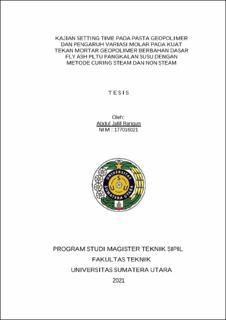| dc.description.abstract | In the construction world for general materials such as cement, sand, gravel and water are used to make a concrete mixture. However, during the cement production process there is a release of carbon dioxide (CO2) gas into the air which is proportional to the amount of cement produced which can damage our environment, including global warming and the greenhouse effect. So we need other alternative materials that can replace cement in the concrete mixture to get environmentally friendly concrete. In this study, the waste from PLTU in the form of fly ash was used to be used as a geopolymer which serves as a substitute for cement in the concrete mixture. Fly ash from the Pangkalan Susu PLTU is used to be mixed into a paste and mortar mixture with the test object in the form of a mortar cube measuring 5cm x 5cm x 5cm by treating the test object by means of plastic covering and room temperature with ages 3, 7, 14 and 28 days. The variation of the alkaline activator used is 6M, 8M and 10M with a ratio of NaSiO3: NaOH is 1: 1.5 and Fly Ash: Alkali Solution is 70%: 30% for each variation of alkali molarity. The test is to test the setting time of pasta and the compressive strength of the geopolymer mortar. . The results of the research is fly ash PLTU Pangkalan Susu is class C fly ash containing 34.81% SiO2, 25.39% CaO, 14.92% Al2O3, 16.49% Fe2O3 and 4.92% MgO in total SiO2, Al2O3, and Fe2O3 compounds are 66.22% with the optimum setting time for the paste is 1 hour 5 minutes with 2% borax added. and 3. And the optimum compressive strength value of geopolymer mortar is found in the mixture with a molarity activator of 10M with room temperature treatment of 32.9 MPa at the age of 28 days, which means that curing with plastic covering does not have a significant effect on the value of the compressive strength of concrete. | en_US |


